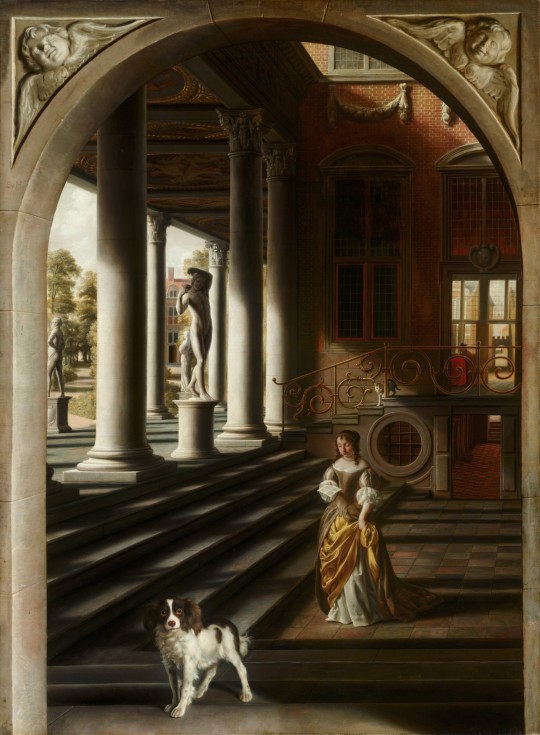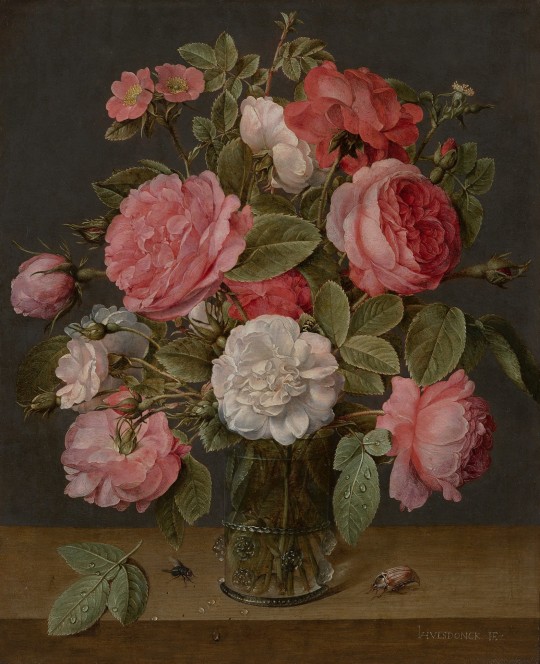Exploring paths of art, from classical to contemporary.
Last active 60 minutes ago
Don't wanna be here? Send us removal request.
Text

The image depicts the Battle of Grunwald, also known as the First Battle of Tannenberg, which took place on July 15, 1410.
It was a decisive confrontation between the Polish-Lithuanian forces and their allies against the Teutonic Knights.
The battle marked the end of the Polish-Lithuanian-Teutonic Wars (1409-1411).
It is considered one of the greatest battles of medieval Europe.
The painting was made by Jan Matejko.
8 notes
·
View notes
Text

The image depicts the painting "The Death of Barbara Radziwiłł."
The painting depicts King Sigismund II Augustus of Poland next to his wife, Barbara Radziwiłł, on her deathbed.
Barbara Radziwiłł was a Lithuanian noblewoman who became Queen of Poland and Grand Duchess of Lithuania.
She died in Kraków on May 8, 1551.
Barbara's death was a significant event in Polish and Lithuanian history, and her love story with Sigismund II Augustus is legendary.
#art#art history#classical art#painting#oil painting#history of art#art blog#european art#women in art
25 notes
·
View notes
Text

The image is the famous painting "Frenzy of Exultations" (Szał uniesień) by Polish artist Władysław Podkowiński.
Artist and Date: Władysław Podkowiński, painted in 1893.
Meaning: Considered the first work of Symbolism in Polish art, it depicts a nude woman on a racing horse, symbolizing passion, ecstasy, and perhaps the untamable nature of emotions.
Controversy: The painting caused a scandal at the time of its exhibition in 1894 due to its bold depiction, and the artist himself damaged it with a knife before the exhibition closed, sparking rumors and speculation.
Current Location: The work is on display at the National Museum in Kraków, Poland.
4 notes
·
View notes
Text

The image depicts an oil painting believed to be "The Sleeping Reader" (or "Nicola D'Inverno") by John Singer Sargent.
The work depicts a man with a mustache and beard, asleep on a book, his head resting on his hand.
The model for the painting is believed to be Nicola D'Inverno, one of Sargent's favorite subjects.
The painting exemplifies Sargent's ability to capture intimate, everyday moments with great realism.
The composition and lighting of the work create an atmosphere of tranquility and introspection.
19 notes
·
View notes
Text

The image is an oil painting on canvas by John Everett Millais, titled "Hearts are Trumps," from 1872.
The work depicts the three daughters of writer and collector Walter Armstrong: Elizabeth, Diana, and Mary, seated around an ornate table, engaged in a game of cards.
The painting is an example of the Realism style and belongs to the genre of genre painting, capturing a moment of everyday life and the interaction between the figures.
The composition highlights the women's expressions and the intricate textures of their elegant dresses, reflecting the fashion of the time.
The painting's title, "Hearts are Trumps," is a reference to the card game and also suggests deeper symbolism, possibly related to emotions and relationships.
The work was acquired by the Tate in 1945 and is considered an icon of the collection, having undergone extensive conservation due to its aesthetic condition.
#art#art history#classical art#painting#oil painting#history of art#art blog#european art#women in art
26 notes
·
View notes
Text

The image depicts the painting "Dorothea and Francesca" (also known as "Dorothea and Francesca Gilder") by American artist Cecilia Beaux.
Artist: Cecilia Beaux (1855-1942), a renowned American painter known for her portraits.
Date: The work was created circa 1898.
Subject: The painting features Dorothea Gilder and her younger sister, Francesca, daughters of the artist's friend, Richard Watson Gilder.
Style: The work is an example of Beaux's portrait style, which combined elements of realism and impressionism, with a focus on capturing the personality and relationships between the subjects.
Location: The painting is in the collection of the Museum of Fine Arts, Boston.
44 notes
·
View notes
Text

The image is the famous painting "Bacchus" by Michelangelo Merisi da Caravaggio.
Artist and Period:
The work was painted by the Italian Baroque master Michelangelo Merisi da Caravaggio (1571–1610) around 1595–1596.
Subject:
The painting depicts Bacchus, the Roman god of wine, reclining in a classical manner, with grapes and vine leaves in his hair.
Work Details:
Bacchus holds a wine glass, and in front of him are a bowl of fruit and a bottle of red wine.
Location:
The painting is currently on display at the Uffizi Gallery in Florence, Italy.
Context:
It was commissioned by Cardinal Del Monte, a year after Caravaggio entered his court during his Roman period.
39 notes
·
View notes
Text

The image depicts Vincent van Gogh's painting "Wheatfield with Reaper."
The work was created in 1889, while Van Gogh was interned at the Saint-Paul-de-Mausole asylum in Saint-Rémy-de-Provence, France.
The painting depicts a reaper working in a wheat field under a bright sun, with mountains in the background.
Unlike "Wheatfield with Crows," which is often associated with the end of the painter's life, "Wheatfield with Reaper" is seen as a representation of life and the cycle of nature, with the reaper symbolizing death, but also harvest and renewal.
It is believed that Van Gogh was inspired by the landscapes he saw from his room's window in the asylum to create this work.
36 notes
·
View notes
Text

The image is the painting "The Swing" (in French: La balaire) by French Impressionist painter Pierre-Auguste Renoir, dated 1876.
The painting depicts a young woman on a swing talking to a man, while a girl and a second man lean against a tree.
The models for the painting were Jeanne Samary, the painter Norbert Goeneutte, and Renoir's brother Edmond.
Renoir painted "The Swing" and "Ball at the Moulin de la Galette" simultaneously in the summer of 1876 in the gardens that are now part of the Musée de Montmartre.
The work was exhibited at the third Impressionist group exhibition in 1877 and later acquired by Gustave Caillebotte. It is currently part of the collection of the Musée d'Orsay.
#art#art history#classical art#painting#oil painting#history of art#art blog#european art#women in art
30 notes
·
View notes
Text

The image shows the painting "Perspective View with a Woman Reading a Letter" by Samuel van Hoogstraten.
Artist:
Samuel van Hoogstraten (1627-1678), a Dutch artist known for his trompe l'oeil and genre paintings.
Date:
The work was created in 1662.
Genre:
It is an example of Dutch genre painting, which often depicted scenes from everyday life.
Details:
The painting features a woman reading a letter in an elaborate architectural setting, with a dog at her side, and is notable for its complex perspective and use of depth.
#art#art history#classical art#painting#oil painting#history of art#art blog#european art#women in art
34 notes
·
View notes
Text

The image depicts the painting "Caesar am Rubikon" (Caesar on the Rubicon) by Wilhelm Trübner.
Artist and Date:
The work was created by the German realist painter Wilhelm Trübner (1851-1917) in 1878.
Subject:
The painting, also known as "Dog with a Plate of Sausages," alludes to the famous phrase "crossing the Rubicon," which means "to pass a point of no return."
Meaning:
Although the title refers to Julius Caesar, the image shows a dog staring at a plate of sausages, suggesting an irreversible decision or temptation.
Technique and Location:
The work is an oil on canvas and measures approximately 48.5 x 61.5 cm. It is currently housed in the Staatliche Kunsthalle Karlsruhe, Germany.
25 notes
·
View notes
Text

The image depicts Lady Frances Finch.
She was an English countess, born Louisa Finch (Thynne) on March 25, 1760.
Lady Frances Finch was a naturalist and botanical illustrator, known for her studies and paintings of plants, algae, and fungi from the Warwickshire region.
She died on December 28, 1832.
#art#art history#classical art#painting#oil painting#history of art#art blog#european art#women in art
16 notes
·
View notes
Text

The image is the work "Bodegón con frutas (con alacrán y rana)" (Still Life with Fruit, Scorpion and Frog) by the Mexican painter Hermenegildo Bustos.
Artist:
Hermenegildo Bustos (1832 - 1907), a self-taught Mexican painter known for his portraits, religious paintings and still lifes.
Date of creation:
1874.
Content:
The painting depicts a variety of agricultural products, including fruits and vegetables in different stages of ripeness, as well as a scorpion and a frog.
Context:
The products depicted are believed to be those with which Bustos had contact in the state of Guanajuato, where he lived.
Current location:
The work is part of the collection of the National Museum of Art (MUNAL) in Mexico, having been acquired by the National Institute of Fine Arts in 1952.
24 notes
·
View notes
Text

The image depicts the painting "Infanta Margarita Teresa in a Blue Dress", painted by Diego Velázquez in 1659. The painting is an oil on canvas and measures 1.27 meters high by 1.07 meters wide. The Infanta Margarita Teresa, portrayed in the work, is the same child who appears in "Las Meninas" (1656). Velázquez used the technique of loose brushstrokes that merge into coherence only when viewed from a distance, especially in the Infanta's dress. The blue silk dress is adorned with silver trim and has a voluminous crinoline, in the Spanish style of the time.
33 notes
·
View notes
Text

The image depicts the Riva degli Schiavoni in Venice, a famous waterfront and quay overlooking the Venetian Lagoon.
The Riva degli Schiavoni is one of the most iconic and bustling locations in Venice, known for its vibrant atmosphere and views of the Doge's Palace and St. Mark's Lagoon.
The name "Riva degli Schiavoni" derives from the merchants from Dalmatia (also known as Slavonia or Schiavonia in the days of the Venetian Republic) who would dock their merchant ships there and set up shop.
The area is characterized by the presence of gondolas and other traditional Venetian vessels, as seen in the painting.
The painting is an example of "veduta", an artistic genre popular in the 18th century that depicted detailed cityscapes, often of Venice.
28 notes
·
View notes
Text

The image shows the painting "Roses in a Glass Vase" by Jacob van Hulsdonck.
Artist: Jacob van Hulsdonck (1582–1647).
Title: Roses in a Glass Vase.
Period: Hulsdonck was a Flemish painter known for his still lifes, especially of flowers and fruit.
Characteristics of the work: The painting depicts a detailed arrangement of roses in a glass vase, with the presence of insects, which were common elements in still lifes of the time to symbolize the transience of life.
110 notes
·
View notes
Text

The image shows the work "Autumn (School)" (originally "Herbst (Schule)") by Marianne von Werefkin.
Artist: Marianne von Werefkin (1860 - 1938), a Russian expressionist painter.
Year: The painting was created around 1907.
Style: Expressionism.
Genre: Genre painting, depicting a scene from everyday life.
Location: The work is currently part of the collection of the Fondazione Marianne Werefkin, located in Ascona, Switzerland.
#art#art history#classical art#painting#oil painting#history of art#art blog#european art#women in art#woman painter#woman artist#art by women
35 notes
·
View notes